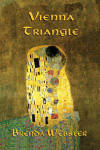ViennaTriangle
Brenda Webster’s new novel, Vienna Triangle, employs the historical context of the early psychoanalysis movement to create a mystery that explores the dark side of intellectual enlightenment. Using Freud and his inner circle as case studies, she investigates the rise of egoism and the tension of professional ambition within the group. Like most historical fiction that focuses on intellectual movements and figures, Vienna Triangle plays largely on the relationship between ideology and character that exists whenever you have someone trying to change our cultural perspective.
Brenda Webster’s new novel, Vienna Triangle, employs the historical context of the early psychoanalysis movement to create a mystery that explores the dark side of intellectual enlightenment. Using Freud and his inner circle as case studies, she investigates the rise of egoism and the tension of professional ambition within the group. Like most historical fiction that focuses on intellectual movements and figures, Vienna Triangle plays largely on the relationship between ideology and character that exists whenever you have someone trying to change our cultural perspective.
The plot is driven by the young graduate student, Kate, who conducts her research like an archaeological detective. Motivated by both professional ambition and personal longing, she digs into the circumstances surrounding the death of Viktor Tausk, Freud’s loyal but disgruntled disciple. As Kate sifts through Tausk’s professional papers and private journals, she finds herself becoming entangled in the movement’s infighting – quickly developing her own set of personal loyalties.
When she meets Helen, a pioneer as an analyst and as a female professional in the nineteen thirties, she is finally able to shine light in the darker corners of the movement’s beginnings. However, the practicality of Helen’s careerism and marital relationship counters and questions the idealistic feminism that Kate had hoped to apply to her own life. As the pieces to her historical puzzle fall into place, Kate’s own life becomes a juggling act between career, self and family – an act very similar to the ones she had uncovered in the young analysts.
As the underlying relationships and rivalries of the group are exposed, questions of intellectual integrity and personal loyalty grow into a truly scandalous set of entanglements – entanglements that threaten to change the very way we view both man and movement. Webster takes a close look at how the image of genius is formed and how it is never a true reflection of reality. As the father of psychoanalysis, Freud needed not only ideas but followers, “to corroborate his findings, and of course [with them] he shone, he stood out like a giant among pygmies.” Webster plays on this struggle within the group dynamic, pitting the individual personalities that also had a need to shine against the confines of the group and the teachings of the guru.
Soon the movement’s need for followers conflicts with its need for intellectual objectivity, leaving Kate and the reader to question its scientific roots: “For a supposedly rational science there was a lot of passionate feeling going around. Sometimes it seems more like a religious sect than a rational science.” Webster brings the destruction caused by an unwavering belief in rationality to the personal lives of her characters, illustrating that the dangers of the true believer can reach deep into science.
As the mystery of the movement is being laid to rest, a state of suspense builds over whether Kate can learn the lessons of history and avoid the same pitfalls of intellectual ambition that befell her predecessors. Kate’s emerging struggle, eerily similar to those facing the analysts of her grandfather’s generation, encapsulates the inherent weakness of human ambition exposed in Vienna Triangle.





